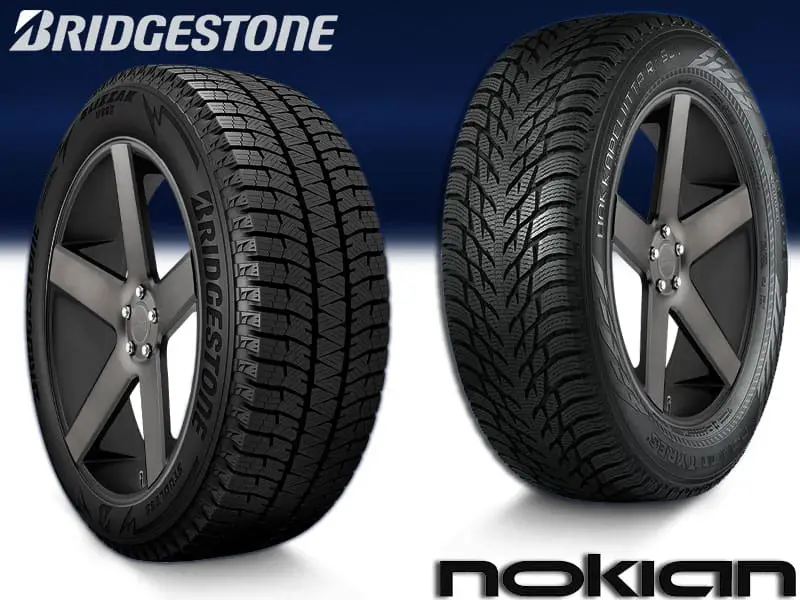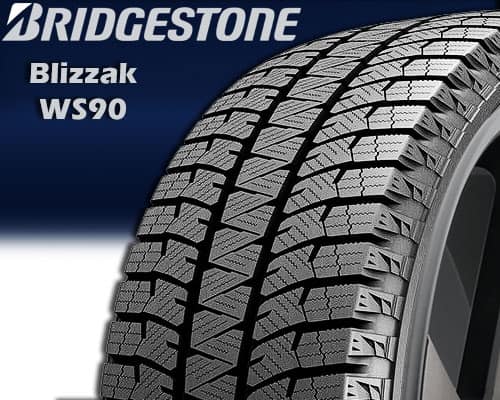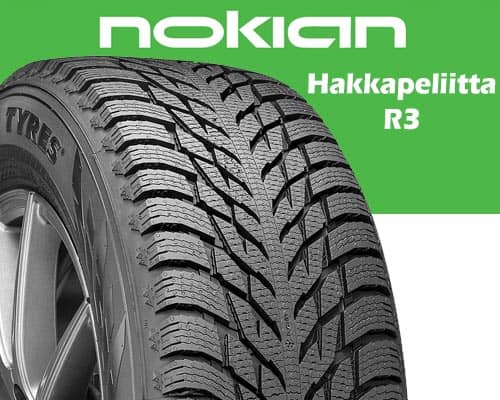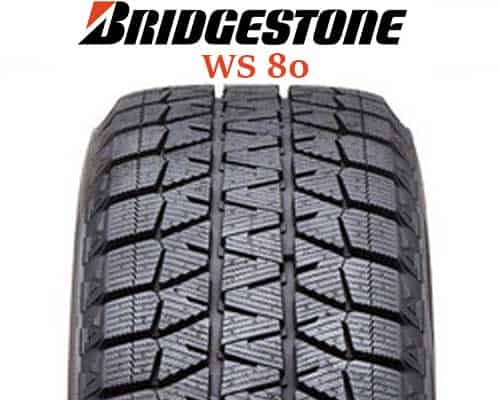Bridgestone Blizzak tires and Nokian Hakapeliitta R3 are both winter tires, where the Blizzak shows heavy-duty performance in snow-packed areas and also gives standard comfort while driving on a dry road. And the Nokian R3 shows superior capacity of grip on wet and frozen surfaces.
Both tires with their prominent tread designs and directional grooves provide ample snow traction, as they are both provided with 3 peak mountain snowflake rating.

Let’s start by analyzing their tread design
Table of Contents
Tread of Blizzak WS90 and Nokian Hakkapeliitta

Vs

Tread of Blizzak WS90 has a symmetrical pattern in which the central rib has a crisscross design that runs circumferentially without any lateral spacing in it.
Two linear grooves are present along its sides and two disconnected grooves are formed by notching of shoulder lugs. It also has multidirectional, zigzag sipes over all of its blocks.
The presence of only a few narrow voids accounts for its relatively larger contact patch which eventually results in better dry traction.
On the other side, a low void ratio proves to be a downside on a wet road as hydroplaning resistivity is reduced.
However, its channels are comparatively deeper and provide a better ability to evacuate snow in a backward direction while rolling over a snow-covered pathway. The tire struggles on ice due to the absence of decent siping.
On the other hand, the Nokian R3 characterizes an aggressive tread that has four circumferential grooves, two of which are disjointed and create a clawed design of tread ribs, multidirectional deep sipes of various widths are marked over its lugs and multi-faceted snow claws are embossed in its voids.
High void ratio reduces contact patch, as a result its tread grips over the dry surface is relatively loose.
On the other side, wider grooves and deeper sipes favor traction on wet surfaces, as water is efficiently wiped from its treads.
Its performance in snow is good as its voids evacuate snow reliably, moreover, engraved snow claws provide biting ability on soft snow yet lesser tread depth makes it stand behind in comparison.
Its ice traction is superior thanks to its deeper sipes, providing good traction.
Road Grip Comparison
Comparatively, Blizzak offers a better grip on the dry surface as it has a relatively large contact patch due to less narrow grooves as well as wide and continuous central rib, resulting in a strong grip of its tread on a dry road.
Although its zigzag sipes and deep voids offer dependable hydroplaning resistivity over wet pavement, however, relatively fewer grooves make it stand behind in the competition.
While rolling on the snow-covered roads, WS90 takes the lead as the depth of its channels is higher than the competitor’s, as a result, they can evacuate snow and slush more efficiently.
Moreover, bite particles present in the tread compound make the tire’s snow traction at its best.
The tire lacks ice griping due to the absence of decent siping.
Owing to its distinct tread design, Nokian R3 possess enough contact patch to give a satisfactory performance on a dry road, nonetheless, its dry grip is lower than the competitor due to its relatively high void ratio.
A higher number of wider grooves and the presence of multidirectional sipes of varied widths make this tire wonderful over slippery surfaces like wet roads as water is wiped off proficiently through these voids.
When R3 is used in snow-packed areas, Cryo crystal 3 particles in tread rubber, many grooves and snow claws among them provide biting edges and evacuation, leading to reliable traction yet its performance is lesser than its competitor as its voids are less deeper, making its evacuation and biting capacity relatively lower.
On the ice, it excels due to the higher number of sipes.
Handling Comparison
WS90 provides fully commanded handling as the vehicle steers along a corner on a dry road because its shoulder lugs are comparatively larger and also possess traction notches to provide additional biting capacity.
However, it stands behind the competitor in terms of steer management over wet surfaces as its shoulders offer relatively lesser aquaplaning efficiency due to its higher contact patch and smaller sipes in comparison.
On the snowy road, it is the game-winner again because its lateral grooves are deeper so they can evacuate snow more efficiently and maintain firm traction while turning.
Furthermore, its tread compound contains bite particles for superior snow traction.
The efficient siping of the tire enhances its ice handling.
Shoulders of Nokian R3 are comparatively smaller and lack traction notches, these qualities make its steer handling on dry road reduced in comparison, as tread holds on the ground less firmly when less of its surface area is in contact with the road.
On the other side, it offers controlled handling on a wet road as its shoulder grooves and wide sipes wipe the water away and the tread can maintain stable traction while taking turns.
On a snow-covered path, R3 presents optimized handling but minimized tread depth makes it less efficient than the competitor.
On the ice, it performs poorly since its shoulders lack enough siping to efficiently steer on ice.
Comparison of Hydroplaning Resistance
Both tires can resist aquaplaning due to their unique tread features, nevertheless, WS90 scores lesser in this respect owing to its low void ratio.
Zigzag sipes over lugs along with linear and disjointed grooves among them pass water easily and reduce the chances of slipping off on the wet roads.
Nokian R3 offers superior resistance against hydroplaning as it has got a higher number of voids over its tread which wipe away water from the surface.
Multidirectional sipes of various widths are marked all over the tread also contribute significantly to the passing of water.
Comparison of Rolling Resistance
Bridgestone WS90 encounters more rolling resistance than its competitor as more surface area of its tread has direct contact with the road, leading to increased friction while rolling.
Therefore, an enormous amount of energy is required to overcome this friction as a result large quantity of fuel is consumed.
Nokian R3 has a high void ratio and minimal contact patch, that’s why it faces less friction against its movement on the road and displays comparatively lower values of rolling resistance.
As less energy is required to overcome the hysteresis produced, it shows a relatively improved fuel average.
Comfort and Noise Comparison
Winter tires are usually noisier than summer tires due to their aggressive tread patterns, so are both of these.
Comparatively speaking, WS90 makes less noise because it has fewer grooves which offer lesser space for reflection and resonation of sound waves.
It is more comfortable on the dry road due to its higher contact patch and low void ratio while the same features are reasoned for decreased comfort on wet paths.
Nokian R3 produces more noise than the competitor due to the high void ratio.
Increased number of wide channels offer more space for the movement and collisions of air particles which result in loud noise when the tire rolls along.
It is relatively uncomfortable on dry pavement due to lesser contact patch while better aquaplaning resistivity makes it more comfortable on a wet road.
Durability and tread wear
The Blizzak WS90 is a less durable option in comparison due to the design and composition of its tread.
It faces more rolling resistance due to a larger contact patch, moreover, its tread wears more quickly after the consumption of its upper layer.
Its tread is built using a dual compound structure in which upper 55% is NanoPro tech multicell compound containing silica enhancements, microscopic bite particles, and hydrophilic coating to ensure exceptional ice and snow traction while lower 45% is Bridgestone’s winter tire compound that is relatively softer rubber.
Nokian R3 last for a relatively longer duration as they face lesser resistance while rolling, resultantly its tread is consumed slowly against the road friction.
Biobased Cryo crystal 3 grip particles have been added into its tread rubber to strengthen it and make its ice grip more stable.
Price Difference
Hakkapeliitta is expensive than its competitor due to its has the economic benefit of better fuel average and relatively slower wear.
On the other side, Bilzzak provides awesome snow traction on a lower price range.
Bridgestone Blizzak WS80 vs Nokian Hakkapeliitta R3

Vs

WS80 has a snow-friendly tread pattern to favor cold climate conditions. It has two major circumferential groove sections which spread over the central ribs, in this way the tire gets a balanced void ratio to give maximum traction on soft snow while performing adequately on dry surfaces.
The wider grooves separating the tread blocks makes the tire reliable on soft snow by delivering excellent grip and handling.
Furthermore, the tread blocks come with prominent biting edges that crush the soft snow efficiently and maintain traction.
The wet traction of this tire is also very impressive as the zig-zag sipes pattern over the wider blocks enhances the grip on wet roads by throwing the water out of tread and maintaining traction with the surface.
However, this tire has to struggle a little bit on dry roads where more speed is required.
R3 has a spectacular tread pattern with adequate groove spacing to favor snowy and wet conditions as well as a balanced contact area to deliver the required grip on asphalt roads.
The central rib is shaped in a leaf-like structure spread all around the tread.
The edge cutting pattern gives this tire relatively more contact patch which enables it to show splendid performance on dry roads and highways.
The relatively lower void ratio makes the tire more stable while going at high speeds.
The bold sidewall lugs provide lateral stability and enhance sidewall protection to increase handling of the tire while cornering on dry roads.
Due to its relatively lower void ratio and a smaller number of grooves the performance of the tire is reduced to some extent in soft snow as compared to its competitor.
However, the dry road and ice traction are reliable.
Grip Comparison
The contact area of tire interacting with the road determines its grip.
WS80 has wide grooves to favor snowy conditions.
This reduces the efficiency of the tire to some extent when we talk about grip on dry roads.
The tire has a limited contact patch which reduces the traction when going at high speeds on paved roads.
As the traction is reduced, the braking distance increases which compromises the stability of the vehicle.
However, the performance in wet conditions increases as numerous sipes spread all over the tread pattern works splendidly to prevent hydroplaning and maintain sufficient grip with the wet road.
If we take the tire on snow, the grip further increases due to wide grooves with deep biting edges that compact the snow to maximize the grip and provide smooth mobility to the tire.
If we consider the grip of R3 on dry asphalt roads, then the results will not disappoint you at all as the densely packed tread pattern provides maximum contact patch to the tire to deliver splendid traction on paved roads.
The relatively lower void ratio assists in providing better grip while going at high and also reduces the braking distance, thus maintaining sufficient stability of the vehicle.
The wet traction of the tire is quite satisfactory but less than its rival.
The tire also comes with sipes that spread all over the tread pattern but is not as efficient when compared to the sipes technology of WS80.
The grip in deep snow is further reduced as it does not have wider grooves.
Nokian R3 performs quite well on ice as it has more contact patch compared to WS80 with numerous sipes to wipe the water away.
Handling Comparison
The Bridgestone WS80 has wider groove spacing over the entire tread with relatively less contact patch.
The high void ratio compromises the handling of the tire to some extent while turning over sharp edges on dry roads.
However, the handling on wet surfaces is increased due to prominent sipes and deep edges. This tire shows its maximum handling on soft snow by evacuating any snow that gets stuck between bold shoulders as it has wide spaces between shoulder blocks.
Overall, the handling performance of both mentioned tires is almost the same but R3 delivers improved handling on dry asphalt roads to some extent as compared to WS80.
The shoulders of Nokian R3 are wider and cover almost one-third of the tread which helps in providing additional lateral stability while cornering over sharp edges.
The bold shoulders enhance sidewall protection to enhance the stability of the vehicle.
The zig-zag sipes pattern along with deep cuts over the shoulders enables the tire to provide better performance on wet roads and prevent hydroplaning.
The handling is reduced a little bit in winter and snowy conditions due to the fewer number of grooves and reduced void ratio as compared to its competitor.
Hydroplaning Resistance Comparison
Hydroplaning occurs on wet and slippery roads where the tire is lifted from the road as a small layer of water is formed between the tire and surface of the road.
This causes loss of grip and makes the tire vulnerable to slipping.
Both the tires give satisfactory hydroplaning resistance WS80 has impressive zig-zag sipes on each section of the longitudinal tread blocks to wipe water efficiently and provide hydroplaning resistance.
R3 does not process efficient capabilities to avoid hydroplaning.
It does not have any grooves to evacuate water which makes it vulnerable to hydroplaning.
But as it has plenty of sipes so they wipe away water really well and enable to it perform well while harsh watery conditions, still it isn’t recommended to use this tire on flooded roads.
Rolling Resistance Comparison
Rolling resistance is the force that resists the motion of the tire while rolling on the road surface.
A tire with more contact patch will require more energy to move smoothly over the surface.
Blizzak WS80 has relatively wider grooves with less contact zone.
This reduces the drag force thus, requiring less effort to maintain the mobility of the tire.
The reduced rolling resistance of WS80 greatly improves fuel efficiency and provides better mileage.
The broad tread design of Nokian R3 with more contact patch increases the surface area of the tire in contact with the road.
So, this tire has more rolling resistance which compromises its fuel efficiency and provides relatively less mileage.
Comfort Comparison
The groove spacing and void ratio determine the comfort of the tire.
WS80 has prominent groove linings stretching over the tread sections.
Due to its higher void ratio, the comfort of the tire is compromised a little bit as it allows more air to enter the broad groove spacing and strike the wall of tread blocks to produce vibrations that leads to noise production.
This reduces the comfort of the tire as it becomes a bit louder while going at high speeds.
The impressive tread design of R3 provides relatively higher contact patch with less void ratio.
The densely packed tread design does not allow much air to enter the open spaces thus, making the tire quieter to deliver more comfort while driving.
The relatively lower void ratio and narrow tread blocks make the tire smooth and provide a stable and comfortable drive by making the tire virtually inaudible.
Durability and Treadwear
WS80 has a multi-Cell compound tread pattern to favor extreme cold conditions without compromising traction with the road.
The micro-texture design along the entire tread blocks gives a neat finish to the tire while providing satisfactory grip on the road.
The efficient zig-zag sipes pattern on the tread blocks works efficiently in wet conditions by evacuating water between the tread and surface to avoid aquaplaning.
The bold shoulders come with saw-toothed edges which increase the handling of the tire and provide extra grip over tricky turns.
The contact patch comes with a balanced void ratio for sufficient traction on dry roads and a confident grip on snowy surfaces.
The tire has relatively less contact patch which reduces the treadwear, thus increasing the durability and mileage of the tire.
Quick Summary
- Bridgestone Blizzak WS80 and Nokian Hakkapeliitta R3, both are Winter tires.
- R3 provides better grip and handling on dry roads.
- WS80 dominates in roads covered with soft snow.
- WS80 has a higher void ratio which significantly decreases rolling resistance and increases fuel efficiency.
- R3 is quieter and provides a more comfortable ride on paved roads.
- Both the tires come within the same price range with varying features.